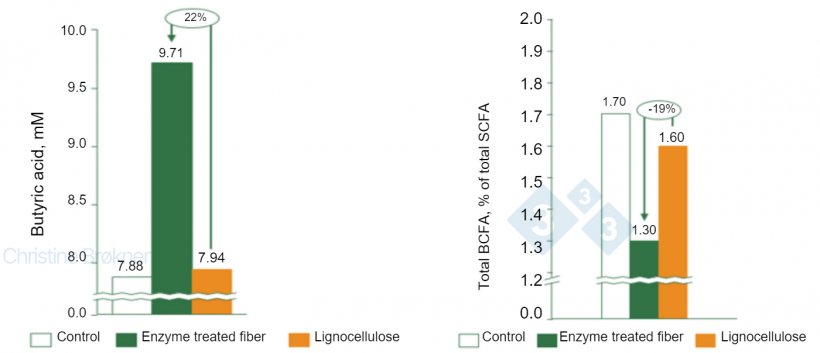Fiber is a natural component in diets for all animals, although it has not historically been attributed any nutritional value. In fact, fiber was undesirable as it reduced energy density and in excess compromised growth performance. This perception is changing and especially towards specialty fibers due to functions that stimulate intestinal health. Fiber is now ascribed a new and equally important value as a functional ingredient used strategically to stimulate the gut and ease the transition at weaning.
Fiber as a tool to promote intestinal health

Gut health is multifactorial and covers three major topics: the diet, the mucosa and the commensal flora. The mucosa and microflora interact with each other forming a frail but dynamic balance that leads to a well-functioning intestinal system. Diets targeting gut health should support this equilibrium between the host and the gut environment to secure healthy and performing animals. Fiber has a role in keeping this balance stable.
The strategic use of fibers to stimulate the gut is related to production of volatile organic acids by fermentation and the physical stimulation throughout the gastro-intestinal system. Fibers are subdivided into soluble and insoluble fibers representing those that are fermented and those that are not. Insoluble fibers have a stabilizing effect on the luminal environment by immobilizing part of the liquid phase, increasing bulk and dry matter content of feces. Additionally, stimulation of peristaltic movements reduces stasis and accumulation of digesta thus preventing adhesions and proliferation of pathogenic bacteria. These functions lead to normal digesta passage rate and stimulate higher feed intake.
Fermentation of soluble fibers starts in piglets as early as 10 kg, in which the ideal content and structure of soluble fibers modulate the underdeveloped microbiome to drive volatile organic acids production and in particular butyric acid. Volatile organic acids are desirable and indicate a functioning microbiota where especially butyric acid stands out by contributing to gut health through enterocyte proliferation, epithelial integrity, and anti-inflammatory functions locally in the lower gut. Butyric acid from microbial fermentation requires anaerobic condition, which is only present in the colon and not in the ileum.

Soluble fibers have an additional interesting feature in particular targeting protein dense diets. Rather than introducing low crude protein diets as the only solution to avoid protein fermentation in the lower gut, one should consider more sophisticated dietary solutions that support early growth e.g. fermentable fibers. Protein bypassing the small intestine is substrate for harmful bacteria; however, much is gained by improving protein digestibility and absorption rate. Soluble fibers are easy substrate compared to protein for commensal bacteria, driving the microflora toward a beneficial bacteria colonization through competitive exclusion. Consequently, putrefactive bacteria and derived harmful metabolites (represented by branched chain fatty acid (BCFA)) i.e. amines, indoles and ammonia products are reduced as protein fermentation is avoided and bypassed protein is excreted.
Understanding fiber analysis
Using fiber as a strategical tool to phase out the use of zinc oxide requires knowledge about which fiber analysis to use in order to formulate diets to have desirable effects. Plant dry matter is conventionally divided into two fractions, the cell wall and cell content. The latter comprises non-structural carbohydrates, which by definition includes starch and simple sugars. Plant cell walls are biphasic structures where cellulose forms a skeleton of microfibrils embedded in a gel-like matrix composed of non-cellulosic polysaccharides, pectic substances and glucoproteins. The main building block of cell walls are mono-sugars uniquely formed to long and branched chains collectively referred to as non-starch polysaccharides (NSP).
Plant cell walls contain up to 950 g/kg DM of various polysaccharides and therefore requires a procedure which can measure a wide range of polysaccharides. Proximate analysis fractionates carbohydrates into crude fiber and nitrogen free extract i.e. sugar and starch. The methodology is easily accessible and widely used to detect fiber content in feedstuffs. However, the method has limitations i.e. soluble NSP and water-insoluble pectin are lost during the analysis. Consequently, the crude fiber concept is underestimating the true fiber concentration in feedstuff.
A more comprehensive methodology is the enzymatic-chemical analytical method that separates carbohydrates according to glycoside linkages, degree of polymerization, solubility of NSP and lignin. The methodology not only reveals fiber content of a feedstuff, it also subdivides carbohydrates according their ability to be enzymatically digested, rapidly or slowly fermented in different sections of the gut system. This subdivision of fibers is beneficial for the strategic use of fibers as a gut modulator.
Underestimation of fiber content and characteristic due to analytical methodology

Balancing dietary fibers correctly between the soluble and insoluble fractions in weaning diets to support the dynamic balance between the mucosa and the microflora brings a completely new dimension to nursery diets. This novel and strategic use of dietary fibers to reduce diarrhea during the vulnerable phase post weaning has potential as a dietary tool when pharmaceutical levels of zinc oxide is no longer a permitted dietary alternative in piglet feeds.



